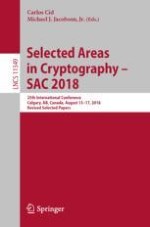This book contains revised selected papers from the 25th International Conference on Selected Areas in Cryptography, SAC 2018, held in Calgary, AB, Canada in August 2018.
The 22 full papers presented in this volume were carefully reviewed and selected from 57 submissions. They cover the following research areas:
design and analysis of symmetric key primitives and cryptosystems, including block and stream ciphers, hash functions, MAC algorithms, and authenticated encryption schemes
efficient implementations of symmetric and public key algorithmsmathematical and algorithmic aspects of applied cryptologycryptography for the Internet of Things
